Magical Creatures Glimpsed on the Set of “Fantastic Beasts”
One of the most exciting parts of the set visit was getting a chance to glimpse a few of the creatures that will be appearing in Fantastic Beasts and Where to Find Them. While I’m sure this is far from a complete list, it’s fun to begin to imagine what kind of chaos these magical animals will be causing in 1920s New York.
We were given between five and ten minutes to explore a board room in which every wall was entirely papered in concept art, not only for beasts but also for characters, sets, props, and more. Needless to say, I was furiously writing the whole time. For some creatures, I was able to jot down a short description, but for others, I had only time to scribble down a name. Remember that this is not a comprehensive or final list, merely creatures that the production team was considering strongly enough to create concept art.
Not all the creatures listed here have entries in the 2001 Rowling-penned bestiary the film is loosely based on, but we’ve included those entries (or excerpts of those entries) where possible. As such, here’s a reminder of the Ministry of Magic Classification system for magical beasts:
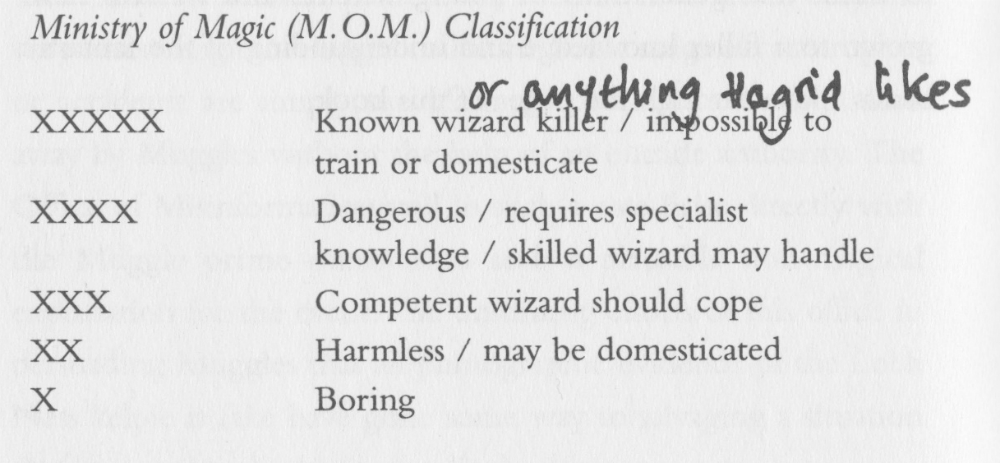
Fwooper
The concept art resembles a bright pink owl.
From Fantastic Beasts:
M.O.M. Classification: XXX
The Fwooper is an African bird with extremely vivid plumage; Fwoopers may be orange, pink, lime green or yellow. The Fwooper has long been a provider of fancy quills and also lays brilliantly patterned eggs. Though at first enjoyable, Fwooper song will eventually drive the listener to insanity, and the Fwooper is consequently sold with a Silencing Charm upon it, which will need monthly reinforcement. Fwooper owners require licences, as the creatures must be handled responsibly.
Niffler
An old favorite from the Harry Potter book series, the Niffler was one of the first creatures we saw in early footage from Fantastic Beasts. Good thing he’s so cute, he never gets old. Plus, I have a suspicion that this Niffler may be the creature that causes havoc in New York’s Diamond District, as hinted at by our tour guide.
From Fantastic Beasts:
M.O.M. Classification: XXX
The Niffler is a British beast. Fluffy, black, and long-snouted, this burrowing creature has a predilection for anything glittery. Nifflers are often kept by goblins to burrow deep into the earth for treasure. Though the Niffler is gentle and even affectionate, it can be destructive to belongings and should never be kept in a house. Nifflers live in lairs up to twenty feet below the surface and produce six to eight young in a litter.

Murtlap
The concept art resembles a cross between a sea anemone and a naked mole rat.
From Fantastic Beasts:
M.O.M. Classification: XXX
The Murtlap is a rat-like creature found in coastal areas of Britain. It has a growth upon its back resembling a sea anemone. When pickled and eaten, these Murtlap growths promote resistance to curses and jinxes, though an overdose may cause unsightly purple ear hair. Murtlaps eat crustaceans and the feet of anyone foolish enough to step on them.
Streeler
From Fantastic Beasts:
M.O.M. Classification: XXX
The Streeler is a giant snail that changes color on an hourly basis and deposits behind it a trail so venomous that it shrivels and burns all vegetation over which it passes. The Streeler is native to several African countries, though it has been successfully raised by wizards in Europe, Asia, and the Americas. It is kept as a pet by those who enjoy its kaleidoscopic color changes, and its venom is one of the few substances known to kill Horklumps.
Diricawl
The concept art looks rather like a fluffy blue dodo bird.
From Fantastic Beasts:
M.O.M Classification: XX
The Diricawl originated in Mauritius. A plump-bodied, fluffy-feathered, flightless bird, the Diricawl is remarkable for its method of escaping danger. It can vanish in a puff of feathers and reappear elsewhere.
Interestingly, Muggles were once fully aware of the existence of the Diricawl, though they knew it by the name of ‘dodo.’ Unaware that the Diricawl could vanish at will, Muggles believe they have hunted the species to extinction. As this seems to have raised Muggle awareness of the dangers of slaying their fellow creatures indiscriminately, the International Confederation of Wizards has never deemed it appropriate that the Muggles should be made aware of the continued existence of the Diricawl.
Billywig
From Fantastic Beasts:
M.O.M. Classification: XXX
The Billywig is an insect native to Australia. It is around half an inch long and a vivid sapphire blue, although its speed is such that it is rarely noticed by Muggles and often not by wizards until they have been stung. The Billywig’s wings are attached to the top of its head and are rotated very fast so that spins as it flies. At the bottom of the body is a long thin sting. Those who have been stung by a Billywig suffer giddiness followed by levitation. Generations of young Australian witches and wizards have attempted to catch Billywigs and provoke them into stinging in order to enjoy these side effects, though too many stings may cause the victim to hover uncontrollably for days on end, and where there is a severe allergic reaction, permanent floating may ensue. Dried Billywig stings are used in some potions and are believed to be a component in the popular sweet Fizzing Whizbees.
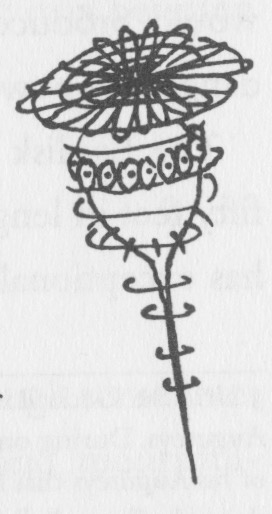

Occamy
In concept art, the Occamy appears both snake-like and bird-like at the same time, not unlike the basilisk from Chamber of Secrets in shape, but blue and shiny, ethereal.
From Fantastic Beasts:
M.O.M. Classification: XXXX
The Occamy is found in the Far East and India. A plumed, two-legged winged creature with a serpentine body, the Occamy may reach a length of fifteen feet. It feeds mainly on rats and birds, though it has been known to carry off monkeys. The Occamy is aggressive to all who approach it, particularly in defense of its eggs, whose shells are made of the purest, softest silver.
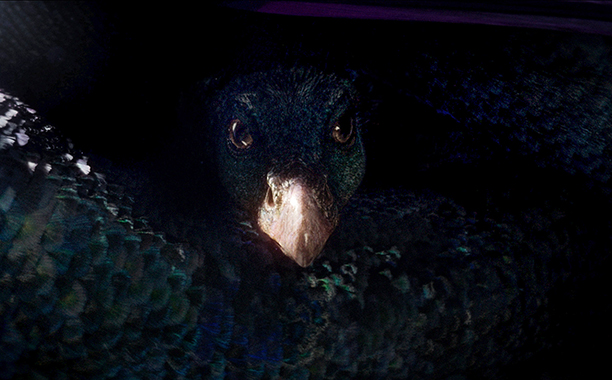
Graphorn
From Fantastic Beasts:
M.O.M. Classification: XXXX
The Graphorn is found in mountainous European regions. Large and grayish purple with a humped back, the Graphorn has two very long, sharp horns, walks on large, four-thumbed feet, and has an extremely aggressive nature. Mountain trolls can occasionally be seen mounted on Graphorns, though the latter do not seem to take kindly to attempts to tame them, and it is more common to see a troll covered in Graphorn scars. Powdered Graphorn horn is used in many potions, though it is immensely expensive owing to the difficulty in collecting it. Graphorn hide is even tougher than a dragon’s and repels most spells.
Giant dung beetle: Speaks for itself!
Hippocampus
From Fantastic Beasts:
M.O.M. Classification: XXX
Originating in Greece, the Hippocampus has the head and forequarters of a horse, and the tail and hindquarters of a giant fish. Though the species is usually to be found in the Mediterranean, a superb blue roan specimen was caught by merpeople off the shores of Scotland in 1949 and subsequently domesticated by them. The Hippocampus lays large, semi-transparent eggs through which the Tadfoal may be seen.
Lethifold
A big, black, floating creature, shaped almost like the body of a stingray, with both octopus and jellyfish-like tentacles.
From Fantastic Beasts:
M.O.M. Classification: XXXXX
The Lethifold is a mercifully rare creature found solely in tropical climates. It resembles a black cloak perhaps half an inch thick (thicker if it has recently killed and digested a victim), which glides along the ground at night. The earliest account we have of a Lethifold was written by the wizard Flavius Belby, who was fortunate enough to survive a Lethifold attack in 1782 while holidaying in Papua New Guinea…As Belby so dramatically reveals, the Patronus is the only spell known to repel the Lethifold. Since it generally attacks the sleeping, though, its victims really have a chance to use any magic against it. Once its prey has been successfully suffocated, the Lethifold digests its food there and then in their bed. It then exits the house slightly thicker and fatter than before, leaving no trace of itself or its victim behind.
Belby’s testimony recounts how a Lethifold crept under his door late one night and attempted to smother him in his sleep. He tries to repel it with many spells before successfully freeing himself using a Patronus Charm. Sounds like there could indeed be very creepy repercussions for Newt and the city of New York!
Bowtruckle:
This creature was labeled only as “Pickett” (since revealed to be this particular Bowtruckle’s name.) My analysis of the concept art? “Like a living plant – think baby Groot, but skinnier” – a description that has since proved pretty accurate!
From Fantastic Beasts:
M.O.M. Classification: XX
The Bowtruckle is a tree-guardian creature found mainly in the west of England, southern Germany, and certain Scandinavian forests. It is immensely difficult to spot, being small (maximum eight inches in height) and apparently made of bark and twigs with two small brown eyes.
The Bowtruckle, which eats insects, is a peaceable and intensely shy creature, but if the tree in which it lives is threatened, it has been known to leap down upon the woodcutter or tree-surgeon attempting to harm its home and gouge out their eyes with its long, sharp fingers. An offering of woodlice will placate the Bowtruckle long enough to let a witch or wizard remove wand-wood from its tree.
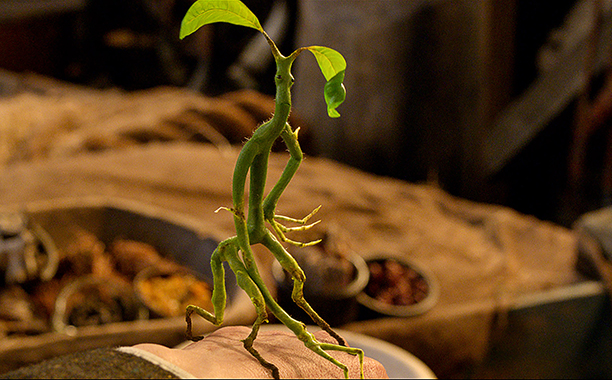
Runespoor
My notes about the concept art, “looks like a 3-headed snake,” matches the description from Fantastic Beasts perfectly!
From Fantastic Beasts:
M.O.M. Classification: XXXX
The Runespoor originated in the small African country of Burkina Faso. A three-headed serpent, the Runespoor commonly reaches a length of six or seven feet. Livid orange with black stripes, the Runespoor is only too easy to spot, so the Ministry of Magic in Burkina Faso has designated certain forces unplottable for the Runespoor’s sole use.
The Runespoor, though not in itself a particularly vicious beast, was once a favorite pet of Dark wizards, no doubt because of its striking and intimidating appearance. It is to the writings of Parselmouths who have kept and conversed with the serpents that we owe our understanding of their curious habits. It transpires from their records that each of the Runespoor’s heads serves a different purpose. The left head (as seen by the wizard facing the Runespoor) is the planner. It decides where the Runespoor is to go and what it is to do next. The middle head is the dreamer (Runespoors may remain stationary for days at a time, lost in glorious visions and imaginings). The right head is the critic and will evaluate the efforts of the left and middle heads with a continual irritable hissing. The right head’s fangs are extremely venomous. The Runespoor rarely reaches a great age, as the heads to tend to attack each other. It is common to see a Runespoor with the right head missing, the other two heads having banded together to bite it off.
The Runespoor produces eggs through its nostrils, the only known magical beasts to do so. These eggs are of immense value in the production of potions to stimulate mental agility. A black market in Runespoor eggs and in the serpents themselves has flourished for several centuries.
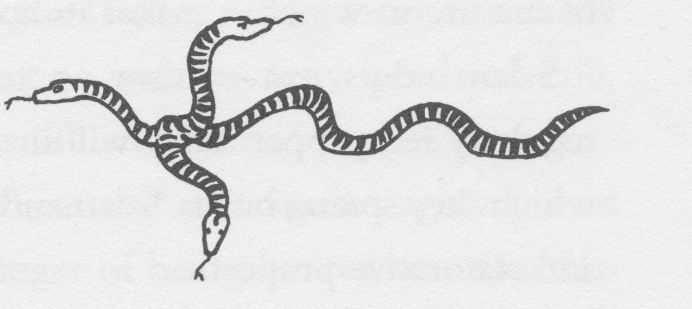
Demiguise
The Demiguise concept art looks like a long-haired sloth.
From Fantastic Beasts:
M.O.M. Classification: XXXX
The Demiguise is found in the Far East, though only with great difficulty, for this beast is able to make itself invisible when threatened, and can be seen only by wizards skilled in its capture.
The Demiguise is a peaceful herbivorous beast, something like a graceful ape in appearance, with large, black, doleful eyes more often than not hidden by its hair. The whole body is covered with long, fine, silky, silvery hair. Demiguise pelts are highly valued, as the hair may be spun into Invisibility Cloaks.

Kappa
This design of this creature looks to be inspired in-part by a Venus flytrap plant.
From Fantastic Beasts:
M.O.M. Classification: XXXX
The Kappa is a Japanese water demon that inhabits shallow ponds and rivers. Often said to look like a monkey with fish scales instead of fur, it has a hollow in the top of its head in which it carries water.
The Kappa feeds on human blood but may be persuaded not to harm a person if it is thrown a cucumber with that person’s name carved into it. In confrontation, a wizard should trick the Kappa into bowing – if it does so, the water in the hollow of its head will run out, depriving it of all its strength.
Erumpent
From Fantastic Beasts:
M.O.M. Classification: XXXX
The Erumpent is a large gray African beast of great power. Weighing up to a ton, the Erumpent may be mistaken for a rhinoceros at a distance. It has a thick hide that repels most charms and curses, a large, sharp horn on its nose and a long, rope-like tail. Erumpents give birth to only one calf at a time.
The Erumpent will not attack unless sorely provoked, but should it charge, the results are usually catastrophic. The Erumpent’s horn can pierce everything from skin to metal and contains a deadly fluid that will cause whatever is injected with it to explode.
Erumpent numbers are not great, as males frequently explode each other during the mating season. They are treated with great caution by African wizards. Erumpent horns, tails, and the Exploding Fluid are all used in potions, though classified as Class B Treatable Materials (Dangerous and Subject to Strict Control).
Swooping Evil
This creature may not appear in the book Fantastic Beasts and Where to Find Them, but Pottermore has given us a little information about it. We’ve also glimpsed it in the Fantastic Beasts trailer.
A large, butterfly-like creature that emerges from a small object, possibly a cocoon.

Bits & Pieces Creature
This one looked exactly as the name suggests! Maybe a background creature? Or was this a shorthand for something else?
Mooncalf
From Fantastic Beasts:
M.O.M. Classification: XX
The Mooncalf is an intensely shy creature that emerges from its burrow only at the full moon. Its body is smooth and pale gray, it has bulging round eyes on top of its head, and four spindly legs with enormous flat feet. Mooncalves perform complicated dances on their hind legs in isolated areas in the moonlight. These are believed to be a prelude to mating (and often leave intricate geometric patterns behind in wheat fields, to the great puzzlement of Muggles).
Watching Mooncalves dance by moonlight is a fascinating experience and often profitable, for if their silvery dung is collected before the sun rises and spread upon magical herb and flower beds, the plants will grow very fast and become extremely strong.
Nundu
The concept art resembles a spiky tiger.
From Fantastic Beasts:
M.O.M. Classification: XXXXX
This East African Beast is arguably the most dangerous in the world. A gigantic leopard that moves silently despite its size and whose breath causes disease virulent enough to eliminate entire villages, it has never yet been subdued by fewer than a hundred skilled wizards working together.
Sounds like Newt, Jacob, Tina, and Queenie may have their work cut out for them on this one!
Doxy
From Fantastic Beasts:
M.O.M. Classification: XXX
The Doxy is often mistaken for a fairy, though it is quite a separate species. Like the fairy, it has a minute human form, though in the Doxy’s case, this is covered in thick black hair and has an extra pair of arms and legs. The Doxy’s wings are thick, curved, and shiny, much like a beetle’s. Doxies are found throughout northern Europe and America, preferring cold climates. They lay up to five hundred eggs at a time and bury them. The eggs hatch in two to three weeks.
Doxies have double rows of sharp, venomous teeth. An antidote should be taken if bitten.

Thestrals
Fans already know all about Thestrals from reading the Harry Potter books – it will be interesting to see how they fit into the Fantastic Beasts story.
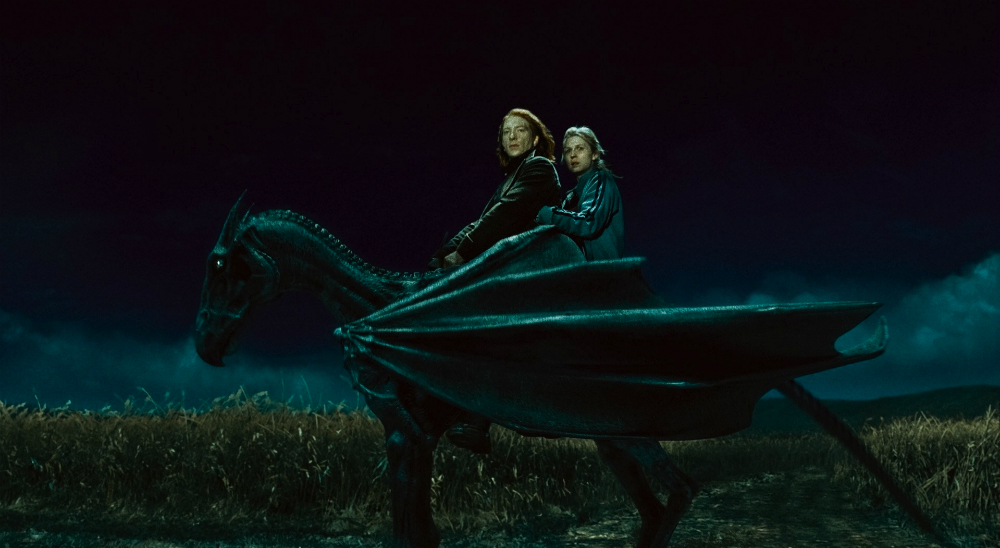
Crup
From Fantastic Beasts:
M.O.M. Classification: XXX
The Crup originated in the southeast of England. It closely resembles a Jack Russell terrier, except for the forked tail. The Crup is almost certainly a wizard-created dog, as it is intensely loyal to wizards and ferocious toward Muggles. It is a great scavenger, eating anything from gnomes to old tires. Crup licenses may be obtained from the Department for the Regulation and Control of Magical Creatures on completion of a simple test to prove that the applicant wizard is capable of controlling the Crup in Muggle-inhabited areas. Crup owners are legally obliged to remove the Crup’s tail with a painless Severing Charm while the Crup is six to eight weeks old, lest Muggles notice it.
You can find links to all of MuggleNet’s Fantastic Beasts and Where to Find Them Set Visit coverage right here.


